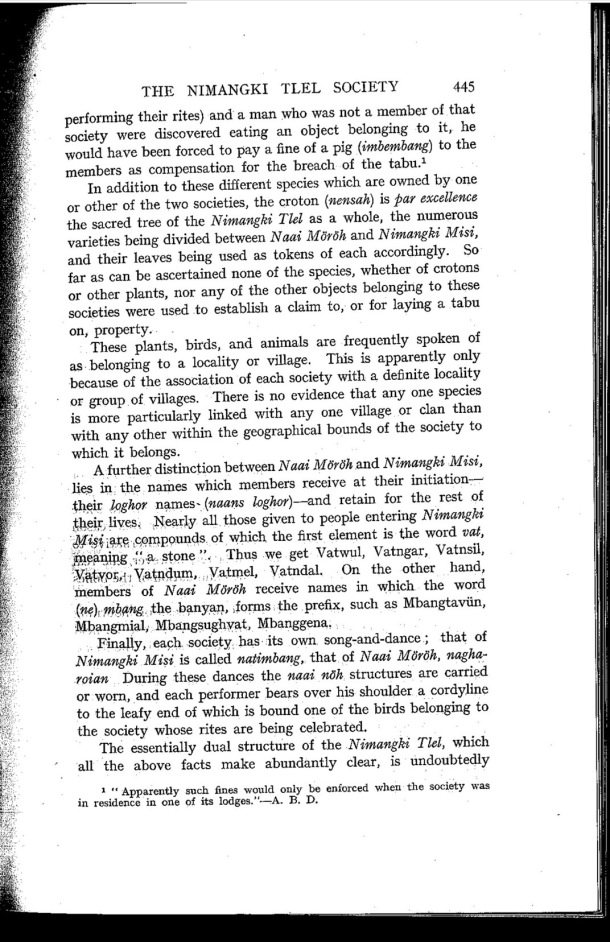|
|  [Note: this transcription was produced by an automatic OCR engine]
R
M",
$3
t‘; .
I41
A -
,.; -.,
L-I, B
W
1
a
Jf
,4!
ti.
(94
.~
»w
»
»
THE NIMANGKI TLEL SOCIETY 445
performing their rites) a.nd a man who was not a member oi that
society were discovered eating an object belonging to it, he
would have been forced to pay a ï¬Åne of a pig (imbembang) to the
members as compensation for the breach of the tabu}
In addition to these different species which are owned by one
or other of the two societies, the croton (nmsah) is par excellence
the sacred tree of the Nimamgki Tlel as a whole, the numerous
varieties being divided between N Mi M 616}; and N imungki Misi,
and their leaves being used as tokens of each accordingly. So
far as can be ascertained none of the species, whether of crotons
or other plants, nor any oi the other objects belonging to these
societies were used to establish a claim to, or for laying a. tabu
on, property.
These plants, birds, and animals are frequently spoken of
as belonging to a locality or village, This is apparently only
because of the association of each society with a deï¬Ånite locality
or group of villages, There is no evidence that any one species
is more particularly linked with any one village or clan than
with any other within the geographical bounds of the society to
which it belongs.
A further distinction between N aai M ï¬Årï¬Åh and Nimangki M isi,
lies in the names which members receive at their initiation-—
their ‘lvoghor names~(naans laghor)-—and retain for the rest of
,t11ei_r,lives._ Nearly all those given to people entering Nimangki
gare ‘compounds of which the first element is the word vat,
jfgieariirig_{.',a‘stone Thus we get Vatwul, Vatngar, Vatnsil,
Z_(atmor,{ flatndum, Yatmel, Vatndal On the other hand,
members of Naai M61611 receive names in which the word
(M) ,m?_1afng the _bany_an, ,forms the preï¬Åx, such as Mbangtaviin,
-Mbangmial, Mbangsughvat, Mbanggena.
.Fi1'lal1y, each society has its own song-and-dance; that of
Nimangki M isi is called natimbzmg, that of Nuai Mï¬Årï¬Åh, nagha;
raian During these dances the naai ndh structures are carried
or worn, and each performer bears over his shoulder a cordyline
to the leafy end of which is bound one of the birds belonging to
the society whose rites are being celebrated.
The essentially dual structure of the Nimangki Tlel, which
all the above facts make abundantly clear, is undoubtedly
_ 1 Apparently such ï¬Ånes would only be enforced when the society was
in residence in one oi “ZS lodges."—A. B. D.
|